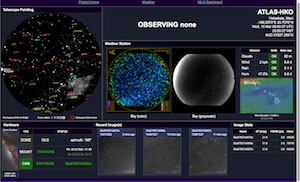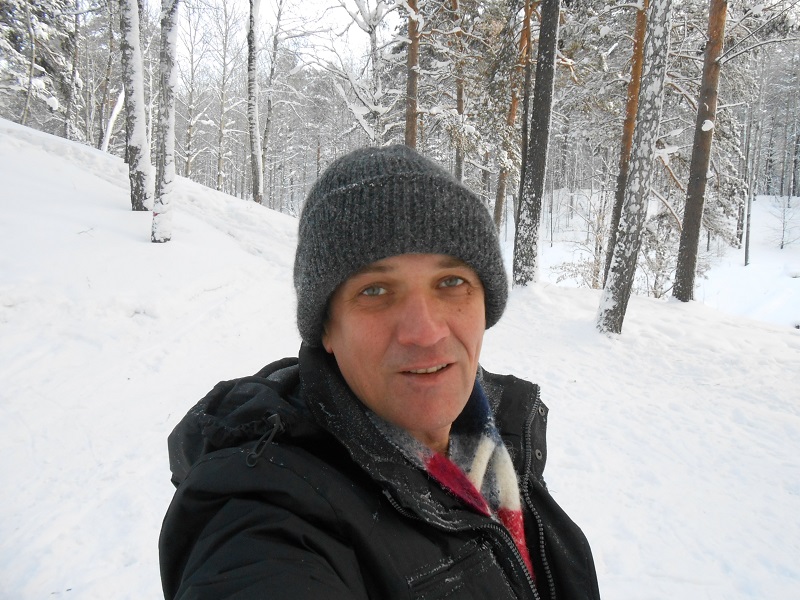ATLAS Update #18: 2017 March
Andrei Sherstyuk
With great sadness we report the passing of our friend and colleague Andrei Sherstyuk at the age of 51. He died suddenly of a heart attack on August 4, 2016, at the Institute for Astronomy. An account of his life, written by his wife and his brother, can be found here.
 ATLAS 2
ATLAS 2
In early February 2017 ATLAS 2 was successfully installed inside its dome at Maunaloa Observatory on the Big Island of Hawaii. More details can be found on our blog pages.
It is now routinely making observations.
ATLAS finds a Virtual Impactor
ATLAS has discovered an asteroid that has a four-in-a-million chance of hitting the Earth between the years 2086 and 2109. More information here.
 ATLAS measures the rotation periods of asteroids
ATLAS measures the rotation periods of asteroids
Many asteroids rotate with periods of a few hours. Unless they are spherically symmetric their brightess can vary due to a) an irregular shape and b) varying reflectivity on different parts of its surface. Since ATLAS makes multiple observations of asteroids we can program our software to look for regularities in its brighness fluctuations and thereby plot a light curve.
The light curve on the right shows an example of an asteroid with a measured period of about 6 hours.
Monitor ATLAS as it observes the sky
 You can now monitor both ATLAS telescopes in real time as they make their nightly observations, weather permitting.
You can now monitor both ATLAS telescopes in real time as they make their nightly observations, weather permitting.
Each page shows whether or not the dome is open and, if so, where the telescope is pointing and whether an exposure is under way. You can also check the real-time weather at the summit, and get a glimpse of the most recent exposure. These pages are routinely used by ATLAS personnel in Honolulu to keep tabs on the observatories.
ATLAS Project achievements over the last 12 months
Here are some of the ways ATLAS's scientists and engineers have upgraded its performance over the last 12 months
- Both ATLAS telescopes, on Haleakala and on Maunaloa, are now in routine operation. ATLAS Maunaloa was successfully installed in January 2017, and ATLAS Haleakala is now visited by a human only about once a month for routine maintenance.
- Our image quality is not as good as it could be, but we have acquired and will install improved Schmidt corrector lenses on both telecopes in April. This should sharpen up the images to critical sampling.
- Each telescope takes about 800 images nightly: we have a better than 99.5% success rate in exposing and digitally reducing these images. Our duty cycle has improved so that each telescope spends 69% of the night with its shutter open, searching for dangerous asteroids. We expect to improve this to 75%.
- As of mid-March 2017, ATLAS Haleakala has taken and stored 276,000 images and ATLAS Maunaloa has taken and stored 21,000 images. With two telescopes and a better duty cycle this cadence is starting to speed up to the steady rate of about a half million images per year.
- Both sites now operate totally robotically with its computers automatically
- deciding whether the weather is suitable for observing,
- deciding when to open and close the dome,
- deciding which patches of sky to observe,
- taking regular exposures,
- storing and calibrating the data
- searching the images for moving and transient objects,
- transferring all the data to our databases in Honolulu,
- sending a list of potentially interesting objects to our human observers at dawn each morning.
One of our staff then spends about 30 - 60 minutes screening the ojects before sending to the Minor Planet Center.
- We have assembled an all-sky reference catalog of some 100 million stars with m < 17. This catalog, derived from the PanSTARRS, APASS, and Gaia surveys, permits 1% photometry and few-milli-arcsecond astrometry. Since every exposure includes a hundred thousand stars with reliably known magnitudes we never make any time-wasting calibration exposures and our astrometry and photometry are extremely accurate.
- Observing 50,000 square degrees every night, we typically photometer about a billion stars and other objects. Our image differencing pipeline reduces this to about 5 million detections of things that have changed in brightness or position (mostly variable stars), and our science clients need that winnowed down even more for the important objects. We are making progress using machine learning algorithms (notably Tensor Flow) to improve the classification of these 5 million detections so that we provide a reliable (high probability of detection but low false alarm rate) stream of objects to our science clients.
- The data collected by ATLAS during its search for dangerous asteroids is stored in databases in Honolulu that can be accessed by colleagues interested in a wide variety of astronomical problems. Among them are:
- The Moving Object Processing System (MOPS) database maintained by the Pan-STARRS project which analyzes detections for moving objects.
- Stationary transients such as supernovae are assembled by our colleagues at Queen's University, Belfast and reported to the Transient Name Server and via ATELs.
- We are alerted by the LIGO/VIRGO consortium when a gravitational wave event has been detected, and we then re-arrange our asteroid observing program to canvas the thousands of square degrees where an optical counterpart might be found.
- The detection database is becoming an incredibly rich all-sky source for time variability of things like asteroid rotation curves, variable stars, eruptive stars, active galactic nuclei, etc.
- The fish-eye cameras attached to the domes of the ATLAS Haleakala and ATLAS Maunaloa observatories are primarly used to monitor cloud coverage. We record and save a horizon-to-horizon image of the sky every 40 seconds. Unlike other astronomy fisheye cameras, we identify and photometer every star in the image. We can detect sources to m~7 in one exposure, m~9.5 in an hour, and m~11 in 10 hours. Because we have two fisheyes operating 100 miles apart we can reject all flashes of light that happen within the atmosphere and focus on the astronomical events. Should a supernova occur in a nearby galaxy (as happened in 1987) we would quickly be able to extract minute by minute light curves well before the time the supernova became visible to the naked eye.
- We have been awarded a new NASA grant for continued operation of ATLAS until 2021, and are optimistic about building two more ATLAS observatories in other parts of the world.
Future ATLAS updates
Now that the construction phase of ATLAS is almost complete we plan to issue future ATLAS updates about once a year, summarizing the improvements we have made to the system in the previous 12 months.
We now use our Twitter acount for short highly topical news items, and our blog pages for more extensive articles.



